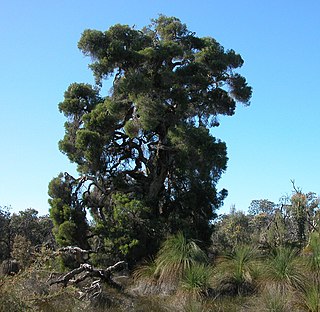
Melaleuca preissiana, commonly known as stout paperbark, modong or moonah, is a plant in the myrtle family, Myrtaceae and is endemic to coastal areas of southwest Australia. It is a shrub or small tree with papery bark, small leaves and spikes of usually white flowers. It occurs chiefly in areas that are seasonally wet.

Melaleuca viridiflora, commonly known as broad-leaved paperbark, is a plant in the myrtle family Myrtaceae, and is native to woodlands, swamps and streams in monsoonal areas of northern Australia and New Guinea. It is usually a small tree with an open canopy, papery bark and spikes of cream, yellow, green or red flowers.
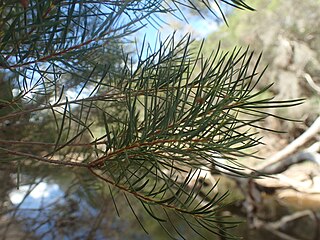
Melaleuca trichostachya is a plant in the myrtle family, Myrtaceae and is native to inland northern New South Wales, Queensland, South Australia and the Northern Territory in Australia. It is a small tree, similar to the commonly cultivated Melaleuca styphelioides, with its prickly foliage and fluffy spikes of white or cream flowers but there are differences in the leaf arrangement and fruiting capsules.
Melaleuca keigheryi is a shrub in the myrtle family, Myrtaceae with white, papery bark and is endemic to the west coast of Western Australia. In spring, it has heads of pink flowers which fade in color to become white.

Melaleuca linguiformis is a plant in the myrtle family, Myrtaceae and is endemic to the south of Western Australia. It is a shrub with hairy new growth, small leaves and heads of white flowers similar to Melaleuca teuthidoides shorter sepals and more stamens in each flower.

Melaleuca stereophloia is a plant in the myrtle family, Myrtaceae and is endemic to the south west of Western Australia. It is similar to the broombush, Melaleuca uncinata with its needle-like leaves and heads of yellow to white flowers, but its bark is hard and fibrous rather than papery.

Melaleuca strobophylla is a shrub or small tree in the myrtle family Myrtaceae and is endemic to the south-west of Western Australia. It has papery bark, sharply pointed, twisted leaves and rather long spikes of creamy white flowers in summer.

Melaleuca acacioides, commonly known as coastal paperbark and as lunyamad by the Bardi people, is a plant in the myrtle family, Myrtaceae and is native to the northern parts of the Northern Territory, Cape York Peninsula and New Guinea. It is closely related to Melaleuca alsophila and Melaleuca citrolens, being differentiated from them by the number of flowers in a group. In this species, they are in groups of three. It is a small to medium-sized tree, sometimes with several trunks when growing in the open. It usually grows in areas with saline soils that are regularly flooded, often near mangroves.
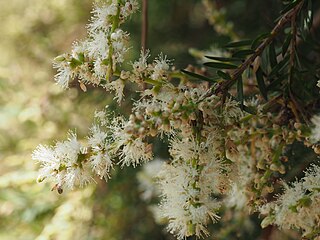
Melaleuca decora, commonly known as the white feather honeymyrtle, is a plant in the myrtle family, Myrtaceae and is native to eastern Australia. It is a large shrub to small tree with papery bark, lance-shaped leaves and sweet-smelling, creamy-coloured flowers in summer. It grows in near-coastal forest and swamps in New South Wales and Queensland.

Melaleuca dealbata, commonly known as karnbor or blue paperbark, is a plant in the myrtle family, Myrtaceae and is native to tropical areas in northern Australia, New Guinea and Indonesia. It is a medium to large leafy tree, growing in wet areas such as on the edges of coastal lagoons. It has papery bark, relatively large, blue-green leaves and spikes of cream-coloured flowers over a long period.
Melaleuca citrolens, commonly known as gulbarn, is a plant in the myrtle family, Myrtaceae and is endemic to northern Queensland and the north-eastern part of the Northern Territory. Plants in this species were originally included in Melaleuca acacioides until a review of the genus in 1986.

Melaleuca fluviatilis is a plant in the myrtle family, Myrtaceae and is endemic to northern Queensland in Australia. It is a tree with papery bark, narrow leaves and spikes of white or creamy-coloured flowers, usually growing along streams and rivers. It is common in tropical areas and is sometimes confused with Melaleuca argentea although it lacks that species' silvery foliage.
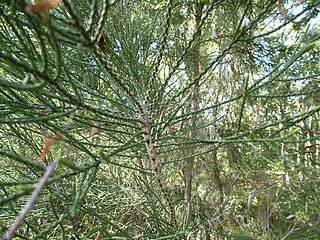
Melaleuca foliolosa is a plant in the myrtle family, Myrtaceae and is endemic to northern Queensland in Australia. It is distinguished by it very small leaves which are pressed against the stem and almost overlap each other.
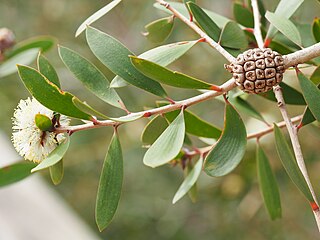
Melaleuca globifera is a shrub in the myrtle family, Myrtaceae and is endemic to the south-west of Western Australia. It is a bushy, small tree with papery bark and spherical heads of flowers on the ends of the branches.

Melaleuca incana, commonly known as grey honey-myrtle, is a plant in the myrtle family, Myrtaceae and is endemic to the south-west of Western Australia and is naturalised in the south of Victoria in Australia. It is commonly grown as a garden plant and produces large numbers of white or creamy yellow flowers, sometimes highly scented, in spring.
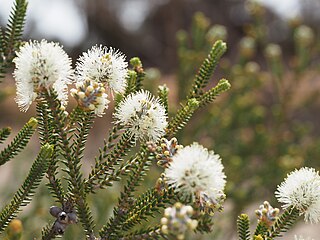
Melaleuca quadrifaria, commonly known as limestone honey-myrtle, is a plant in the myrtle family, Myrtaceae, and is native to the south of Western Australia. It is distinguished by the small size and arrangement of its leaves combined with its small spikes of white or cream flowers.
Melaleuca saligna is a shrub or tree in the myrtle family (Myrtaceae) and is endemic to Cape York Peninsula in Queensland. It is a small tree with papery bark on the trunk, pendulous branches and white to greenish-yellow flowers between February and November. This species should not be confused with Callistemon salignus. If that species were to be moved to the genus Melaleuca, as proposed by some authors, its name would become Melaleuca salicina. Melaleuca saligna has its stamens arranged in bundles; the stamens of Callistemon salignus/Melaleuca salicina are all free.

Melaleuca sieberi is a shrub or tree in the myrtle, family Myrtaceae, which is endemic to coastal areas of New South Wales and Queensland. It is a large shrub or small tree with papery bark on the trunk, small, sharp leaves and small heads of fluffy flowers in spring. It should not be confused with Callistemon sieberi. When the callistemons were moved to Melaleuca, Callistemon sieberi became Melaleuca paludicola.

Melaleuca stenostachya, commonly known as fibre-barked teatree or straight teatree is a plant in the myrtle family Myrtaceae and is native to the Cape York Peninsula in northern Australia, the gulf country of the Northern Territory and the south of Papua New Guinea. It is closely related to Melaleuca dealbata but can be distinguished from that species by the wide separation of the flowers in the inflorescence.
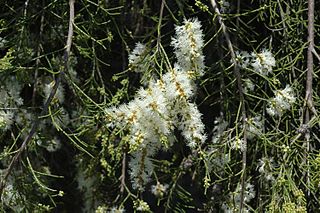
Melaleuca tamariscina, commonly known as bush-house paperbark or tamarix honey-myrtle is a plant in the myrtle family, Myrtaceae and is endemic to central Queensland in Australia. It grows to the height of a small tree with small, scale-like leaves that are pressed against the branches, and has a papery bark and a weeping habit.

















